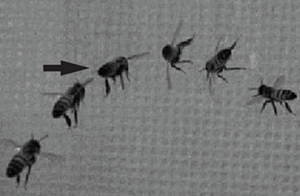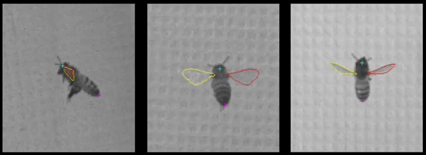Sponsor: AFOSR (Doug Smith)
Investigators: PI: Wei Shyy (Univ of Michigan), Co-PIs: Sean Humbert (UMD), Jason Vance (College of Charleston)

The small size and proposed maneuverability of micro aerial vehicles (MAVs) provide immense potential to improve surveillance in the contexts of security and exploration of novel and/or remote landscapes. The success of MAVs will depend on the ability to vary aerodynamic output in response to perturbations, such as gusts of wind or turbulence associated with flight in heterogeneous environments.
This research investigates the kinematic and aerodynamic mechanisms of gust rejection employed by insects, in particular the European honey bee (Apis mellifera), the blowfly (calliphora vicina) and the stalk-eyed fly.
Multi-camera, high-speed videography is used to film animals during free-flight and simulated forward flight (via small-scale wind tunnel) as they encounter variable-strength gusts and turbulence. The three-dimensional wing and body kinematics are reconstructed from these video sequences, and the flight dynamics and control are modeled to characterize how insects mitigate environmental perturbations and develop strategies applicable to MAVs and other small-scale autonomous flying vehicles.

Publications
- Humbert JS and Faruque I, “Analysis of Insect-Inspired Wingstroke Kinematic Perturbations for Longitudinal Control,” AIAA J. of Guidance, Control and Dynamics, Vol. 34, No. 2, pp. 618-623, 2011, DOI: 10.2514/1.51912.
- Grauer J, Ulrich E, Hubbard JE, Pines DJ, Humbert JS, “Testing and System Identification of an Ornithopter in Longitudinal Flight,” AIAA Journal of Aircraft, Vol. 48, No. 2, pp. 660-667, 2011, DOI: 10.2514/1.54008.
- Roget B, Sitaraman J, Harmon R, Grauer J, Hubbard JE, Humbert JS, “Computational Study of Flexible Wing Ornithopter Flight,” AIAA Journal of Aircraft, Vol. 46, No. 6, pp. 2016-2031, 2010, DOI: 10.2514/1.43187.
- Grauer J, Ulrich E, Hubbard JE, Pines DJ, and Humbert JS, “Model Structure Determination of an Ornithopter Aerodynamics Model from Flight Data,” AIAA Aerospace Sciences Meeting, AIAA-2010-41, Orlando, Florida, 2010.
- Grauer J, Ulrich E, Hubbard JE, Pines DJ, and Humbert JS, “System Identification of an Ornithopter Aerodynamics Model,” AIAA Conference on Guidance, Navigation, and Control, AIAA-2010-7632, Toronto, Canada, 2010.
- Vance JT, Faruque I, and Humbert JS, “Kinematic Strategies for Mitigating Gust Perturbations in Insects,” Bioinspiration and Biomimetics, Vol. 8, No. 1, 2013, DOI: 10.1088/1748-3182/8/1/016004.
- Collett AN, Vance J and Humbert, JS, “Optomotor Response to Simulated Egomotion During Tethered Flight in Honey Bees, Apis mellifera,” Society of Integrative and Comparative Biology, Annual Meeting; Portland, OR, January 3-7, 2016.
- Vance J and Humbert, JS, “Optomotor Response to Simulated Yaw Rotations During Tethered Flight in Honey Bees, Apis mellifera,” Society of Integrative and Comparative Biology, Annual Meeting; Palm Beach, FL, January 3-7, 2015.
- Vance JT, Faruque IA and Humbert JS, “Strategies for Mitigating Gust Perturbations in Insects,” 7th Annual World Congress of Biomechanics, Boston, MA, July 6-11, 2014.
- Vance J, Faruque IA, and Humbert JS, “Mechanisms of Gust Rejection in Stalk-Eyed Flies,” 8th International Congress of Dipterology, Potsdam, Germany, August 10-15, 2014.
- Vance J and Humbert, JS, “Optomotor Response to Simulated Yaw Rotations During Tethered Flight in Apis mellifera,” Society of Integrative and Comparative Biology, Southeast Regional Meeting for Division of Vertebrate Morphology and Division of Comparative Biomechanics, Chapel Hill, NC, October 22, 2014.
- Vance JT and Humbert JS, “Mechanisms of Gust Rejection in the Honeybee Apis mellifera,” Society for Integrative and Comparative Biology, Seattle, Washington, January 2010.
- Vance JT and Humbert JS, “The Effects of Differential Wing Stroke Amplitude and Offset on Insect Body Moments During Perturbed Flight Conditions,” American Society of Biomechanics, Rhode Island, August 2010.
- Harmon R, Grauer J, Hubbard J, and Humbert JS, “Experimental Determination of Ornithopter Membrane Wing Shapes used for Simple Aerodynamic Modeling,” AIAA Atmospheric Flight Mechanics Conference, AIAA-2008-6237, Honolulu, Hawaii, 2008.
- Roget B, Sitaraman J, Harmon R, Grauer J, Conroy JK, Hubbard JE Jr, Humbert JS, “A Computational Study of Flexible Wing Ornithopter Flight,” AIAA Applied Aerodynamics Conference, AIAA-2008-6397, Honolulu, Hawaii, 2008.
